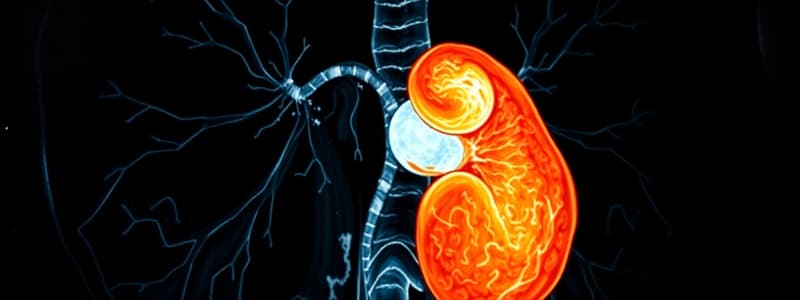Podcast
Questions and Answers
What is the primary effect of RAS on glomerular filtration rate (GFR)?
What is the primary effect of RAS on glomerular filtration rate (GFR)?
- Increases GFR by enhancing renal perfusion pressure
- Decreases GFR by reducing filtration pressure (correct)
- Causes GFR to fluctuate without a clear trend
- Has no effect on GFR or renal perfusion
How do ACE inhibitors assist in diagnosing renovascular hypertension?
How do ACE inhibitors assist in diagnosing renovascular hypertension?
- They directly increase renal blood flow
- They reveal abnormal GFR despite normal baseline renograms (correct)
- They permanently restore normal GFR levels
- They eliminate the need for renal imaging altogether
What change occurs in GFR when ACE inhibitors block the conversion of angiotensin I to angiotensin II?
What change occurs in GFR when ACE inhibitors block the conversion of angiotensin I to angiotensin II?
- GFR becomes unstable and frequently fluctuates
- GFR remains unchanged regardless of ACE inhibitor action
- GFR markedly increases due to reduced vascular resistance
- GFR decreases due to decreased glomerular filtration pressure (correct)
What pre-study preparation is recommended for patients undergoing renal imaging with ACE inhibitors?
What pre-study preparation is recommended for patients undergoing renal imaging with ACE inhibitors?
What is a common adverse effect of ACE inhibitors?
What is a common adverse effect of ACE inhibitors?
In what condition would you expect to see an abnormal renogram when using ACE inhibitors?
In what condition would you expect to see an abnormal renogram when using ACE inhibitors?
What should be monitored every 10-15 minutes during the infusion of an ACE inhibitor?
What should be monitored every 10-15 minutes during the infusion of an ACE inhibitor?
When should a renal tracer be injected after enalaprilat administration?
When should a renal tracer be injected after enalaprilat administration?
Flashcards
What is the RAS?
What is the RAS?
Renin-angiotensin system (RAS) regulates blood pressure and filtration rate in the kidneys.
How do ACE inhibitors affect blood flow?
How do ACE inhibitors affect blood flow?
ACE inhibitors block the conversion of angiotensin I to angiotensin II, decreasing vasoconstriction and improving blood flow to the kidneys.
How can ACE inhibitors aid in diagnosing kidney problems?
How can ACE inhibitors aid in diagnosing kidney problems?
ACE inhibitors can help diagnose renovascular hypertension by revealing abnormal GFR even when baseline renograms are normal.
What are some side effects of ACE inhibitors?
What are some side effects of ACE inhibitors?
Signup and view all the flashcards
How do ACE inhibitors help diagnose renovascular hypertension?
How do ACE inhibitors help diagnose renovascular hypertension?
Signup and view all the flashcards
What is the pre-study preparation for renal imaging with ACE inhibitors?
What is the pre-study preparation for renal imaging with ACE inhibitors?
Signup and view all the flashcards
Why is monitoring important during and after ACE inhibitor infusion?
Why is monitoring important during and after ACE inhibitor infusion?
Signup and view all the flashcards
Name some common ACE inhibitors used in renal imaging.
Name some common ACE inhibitors used in renal imaging.
Signup and view all the flashcards
Study Notes
Renal Imaging with ACE Inhibitors
-
Renovascular Hypertension Diagnosis: ACE inhibitors play a role in diagnosing renovascular hypertension, which is caused by a narrowing of the renal arteries (renal artery stenosis, RAS). This condition directly impacts glomerular filtration rate (GFR).
-
RAS Impact on GFR: The renin-angiotensin-system (RAS) reduces filtration pressure and GFR due to decreased blood flow to the kidneys.
-
Renin Compensation: The juxtaglomerular apparatus (JG) releases renin to counteract the effects of RAS.
-
Angiotensin II's Role: Angiotensin II, a hormone produced from angiotensin I, causes constriction in the efferent arteriole to maintain filtration pressure and GFR. This is crucial in maintaining kidney function.
-
ACE Inhibitors and Abnormal GFR: These medications interfere with the conversion of angiotensin I to angiotensin II. This can lead to a decreased glomerular filtration rate, which might appear abnormally low compared to a normal baseline renogram (a test measuring blood flow and filtration in the kidneys). This abnormal result could indicate renovascular hypertension.
-
Mechanism of Action: ACE inhibitors block the conversion of angiotensin I to angiotensin II. This results in a decrease in glomerular filtration pressure and an abnormally low GFR.
-
Impact on Renal Perfusion: Renal perfusion might initially appear normal or even increased, due to the decreased resistance in the blood vessels.
-
GFR Agent Uptake: Uptake of contrast agents designed to measure GFR can be initially reduced, but prolonged retention may occur due to decreased GFR.
-
Renogram Indications: An abnormal renogram suggests a high likelihood of renovascular hypertension caused by renal artery stenosis.
-
Pre-Study Preparation (Patient Instructions): Patients should stop ACE inhibitor therapy 3-7 days prior to the procedure and remain well-hydrated, and void before the test.
-
Baseline Measurements: Before ACE inhibitor administration, baseline sitting and standing blood pressure and heart rate are recorded.
-
Post-Infusion Monitoring: Post infusion, blood pressure and pulse are closely monitored every 10-15 minutes to ensure stability. Patients are not released until their standing blood pressure returns to at least 70% of baseline values.
ACE Inhibitor Medications
-
Commonly Used: Captopril (Capoten) and enalaprilat (Vasotec IV) are common ACE inhibitor types used in diagnostics.
-
Captopril Dosage and Administration: 25-50 mg orally, dissolved in water for better absorption. Administer 60 minutes after intake for optimum blood pressure.
-
Enalaprilat Dosage and Administration: 40 mg/kg in 10 mL normal saline. Delivered intravenously over 3-5 minutes.
-
Administration Timing (Tracer): Inject the renal tracer at least 15 minutes after enalaprilat administration.
Adverse Effects
- Common side effects include orthostatic hypotension, dizziness, chest pain, headache, dry cough, electrolyte imbalances, fatigue, abdominal pain, vomiting, and diarrhea.
Studying That Suits You
Use AI to generate personalized quizzes and flashcards to suit your learning preferences.





